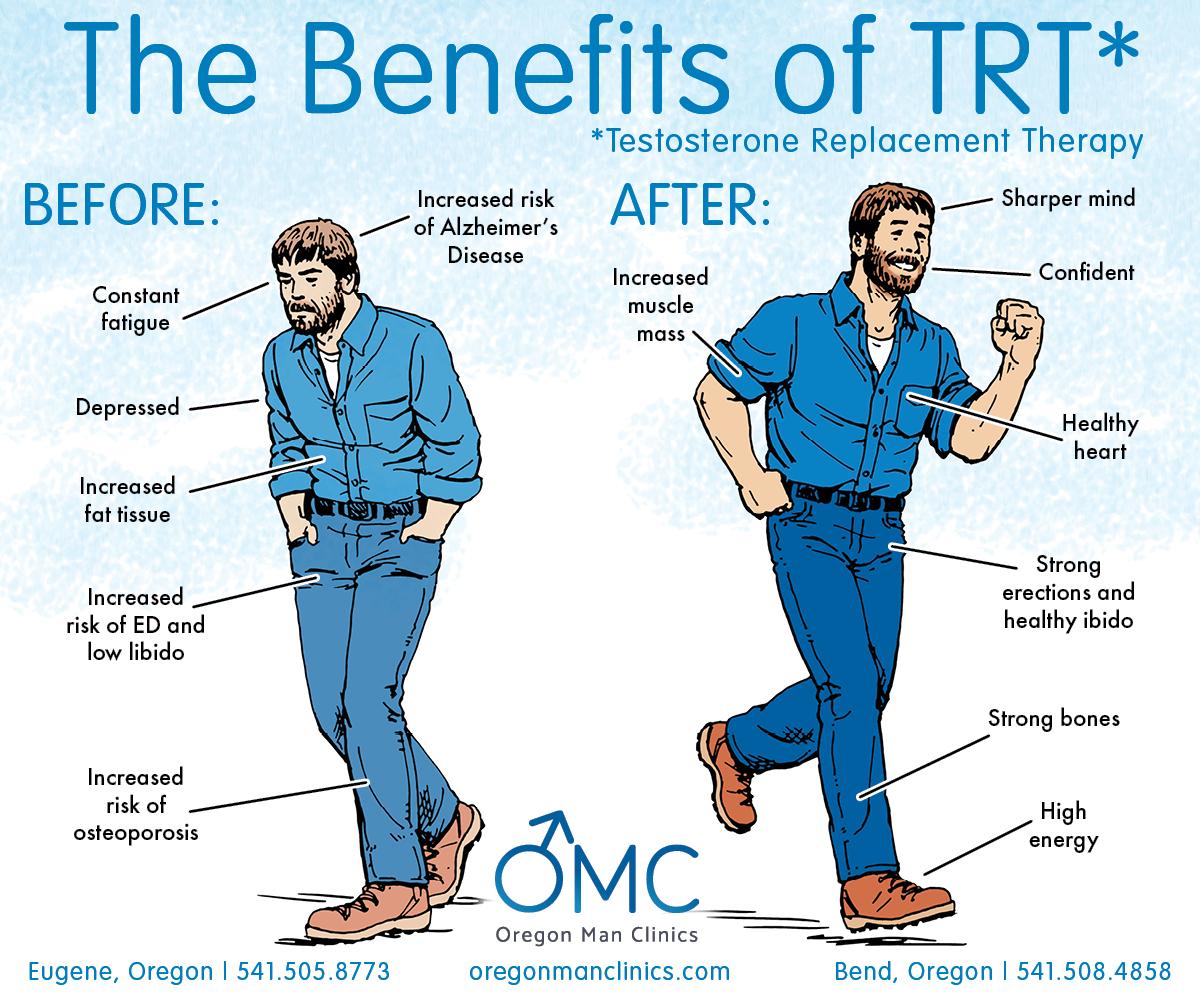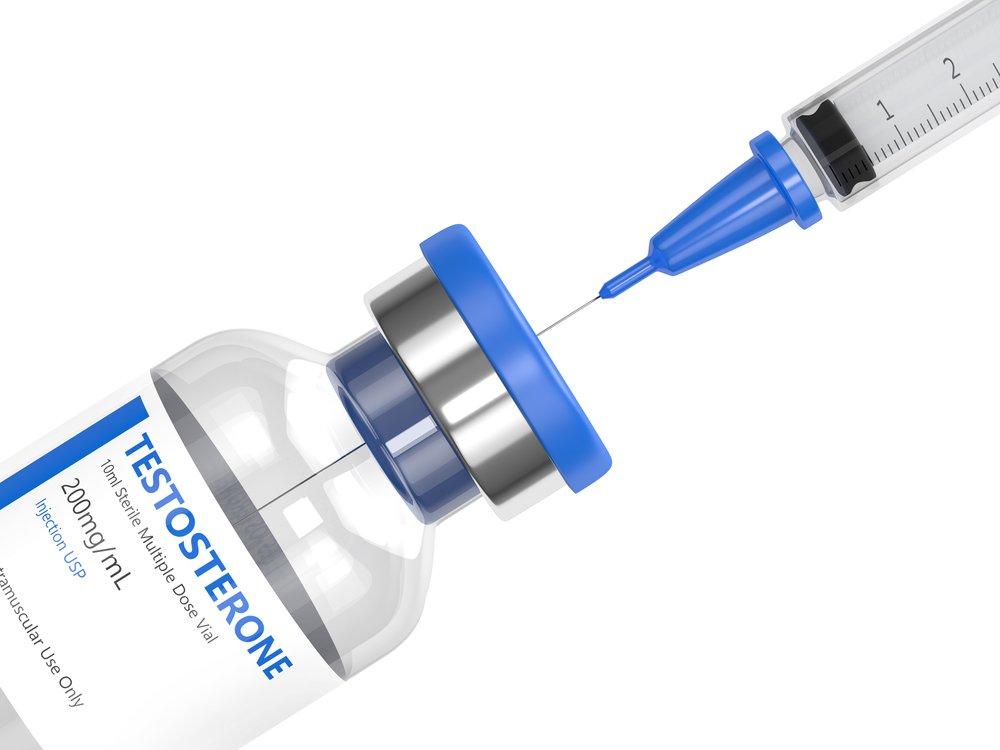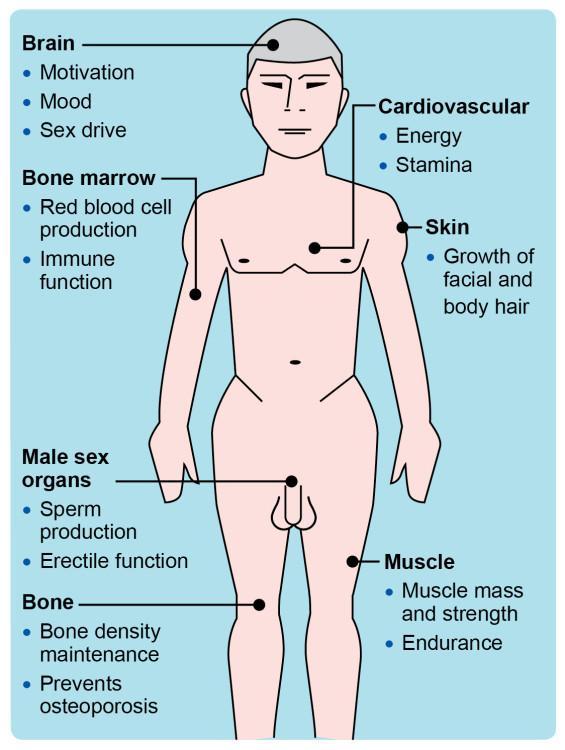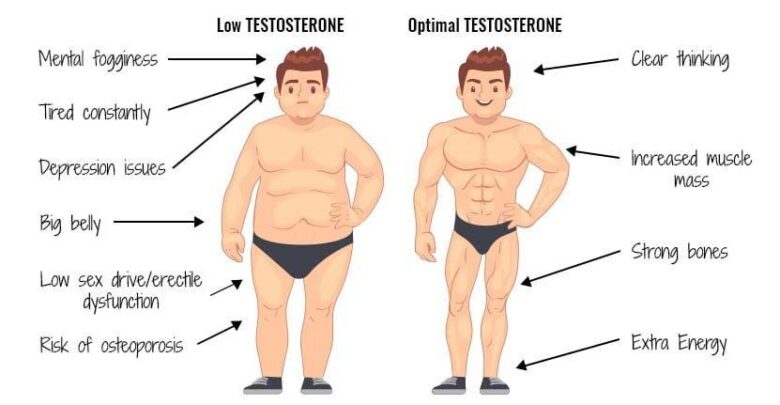As the years roll on, many men find themselves facing an unexpected change — a shift that often goes unnoticed until it begins to affect daily life. Enter testosterone therapy, a beacon of hope for those navigating the landscape of aging after 40. In a world where vitality is often equated with youth, men may grapple with fatigue, diminished libido, and a cloud of mental fog that seems to settle in uninvited. But what if there was a way to reclaim some of that lost vigor? This article delves into testosterone therapy, exploring its potential benefits and risks for men in this age bracket, as well as the science behind hormone levels and their impact on overall health. Join us as we embark on a journey to better understand how testosterone therapy could help redefine vitality in the second act of life.
Understanding Testosterone and Its Role in Mens Health
Testosterone, often dubbed the “male hormone,” plays a crucial role in various aspects of health and well-being for men, especially as they age. Its functions extend beyond just affecting libido; it is instrumental in maintaining muscle mass, bone density, and red blood cell production. Men over 40 may experience a natural decline in testosterone levels, a process often referred to as andropause. This gradual decrease can lead to a variety of symptoms, including fatigue, decreased motivation, and mood fluctuations. Understanding these changes and their implications on daily life is vital for men seeking to optimize their health and wellness.
For those considering testosterone replacement therapy (TRT), it’s essential to assess potential benefits and risks. With appropriate clinical evaluation, men can explore therapies designed to bring hormone levels back to a more youthful state. Key factors to discuss with healthcare providers include:
- Potential benefits: Increased energy, enhanced mood, and improved sexual function.
- Risks: Possible cardiovascular concerns, prostate health implications, and hormone-related side effects.
- Monitoring: Regular blood tests to check testosterone levels and overall health.
The decision to start TRT should be made collaboratively with healthcare professionals, ensuring that the approach aligns with individual health goals and circumstances.

Identifying Signs and Symptoms of Low Testosterone
Recognizing the signs of low testosterone can be crucial for men over 40, as it often goes unnoticed or attributed to aging. Common symptoms include fatigue, decreased energy levels, and loss of muscle mass. Additionally, men may experience changes in mood, such as increased irritability or depression, alongside a notable decline in libido. It’s important for men to pay attention to these indicators and seek appropriate testing.
Other physical symptoms may present themselves as well. These can include:
- Weight Gain: Increase in body fat, particularly in the abdominal area.
- Sleep Issues: Difficulty falling asleep or experiencing disrupted sleep patterns.
- Difficulty Concentrating: Challenges with focus, memory, or cognitive tasks.
Additionally, laboratory tests can provide valuable insights into testosterone levels. Here’s a quick overview of critical measurements often evaluated:
| Test | Normal Range |
|---|---|
| Total Testosterone | 300 – 1,000 ng/dL |
| Free Testosterone | 50 – 210 pg/mL |
| Luteinizing Hormone (LH) | 1.24 – 7.8 mIU/mL |
| Follicle-Stimulating Hormone (FSH) | 1.5 – 12.4 mIU/mL |

The Benefits of Testosterone Therapy for Men Over 40
For men over 40, the natural decline in testosterone can lead to various physical and emotional challenges. Testosterone therapy can act as a lifeline, offering numerous benefits that enhance overall quality of life. Among these benefits, improved energy levels are notable, as many men experience fatigue and decreased motivation as they age. Furthermore, therapy can contribute to increased muscle mass, aiding in weight management and physical fitness, which is especially important as metabolic rates slow down with age.
In addition to physical benefits, testosterone therapy often positively impacts mental clarity and mood, potentially alleviating feelings of depression and anxiety commonly associated with low testosterone levels. Studies suggest that men undergoing therapy report enhancements in libido, leading to improved relationships and sexual health. To summarize the key benefits, consider the following:
- Enhanced energy and vitality
- Increased muscle mass and strength
- Improved mood and mental clarity
- Boosted libido and sexual health

Choosing the Right Type of Testosterone Replacement Therapy
When it comes to testosterone replacement therapy, men over 40 have several options to consider. Each type has its own unique benefits and potential drawbacks, making it crucial to evaluate each one carefully. Options include:
- Injectable Testosterone: Typically administered every one to two weeks, this method offers rapid effects and precise dosage adjustments, though it may involve discomfort and requires regular visits to a healthcare provider.
- Transdermal Patches: Easy to apply and convenient for daily use, patches provide a steady release of testosterone. However, they may cause skin irritation in some users.
- Topical Gels: These products allow for daily application and absorption through the skin. Proper application and hygiene are essential to avoid transferring testosterone to others.
- Pellets: Implanted under the skin, pellets release testosterone over several months, offering a “set it and forget it” solution. The initial procedure requires minor surgery but often leads to stable hormone levels.
Choosing the right approach depends not only on personal preference but also on lifestyle, comfort level with administration methods, and specific health considerations. A thorough consultation with a healthcare professional should evaluate factors such as:
| Factor | Considerations |
|---|---|
| Health History | Existing conditions like heart disease or prostate issues may influence the choice. |
| Convenience | Frequency of administration and how it fits into daily routines is essential. |
| Cost | Insurance coverage and overall expenses vary widely among different therapies. |
| Side Effects | Understanding potential side effects is critical to making an informed decision. |
Potential Risks and Considerations of Hormone Treatments
Engaging in testosterone therapy can present various potential risks and considerations that men over 40 should carefully evaluate. While the benefits may include increased energy levels, improved mood, and enhanced muscle mass, the associated risks warrant thorough discussion with a healthcare provider. Some potential concerns include:
- Cardiovascular Issues: Testosterone therapy has the potential to increase the risk of heart disease, particularly in men with pre-existing conditions.
- Prostate Health: An elevated testosterone level may aggravate existing prostate issues or stimulate the growth of prostate cancer.
- Sleep Apnea: Men undergoing treatment might experience worsening of sleep apnea, a serious sleep disorder.
- Hormonal Imbalance: An excess in testosterone can lead to secondary health problems, including gynecomastia and infertility.
Beyond physiological impacts, psychological effects should also be taken into account. Individuals might experience mood swings, irritability, or aggressive behavior, which can affect both personal and professional relationships. It’s crucial to monitor emotional well-being post-therapy and to consider how hormonal fluctuations might impact overall mental health. Additionally, establishing regular follow-ups for:
| Monitoring Parameter | Recommended Frequency |
|---|---|
| Blood Pressure | Every 3-6 months |
| PSA Levels | Annually |
| Blood Lipids | Every 6-12 months |
is essential to mitigate risks and evaluate the impact of treatment on overall health.
Monitoring and Managing Treatment Effectiveness
Evaluating the effectiveness of testosterone therapy involves a combination of objective tests and subjective assessments. Regular monitoring is essential to ensure that testosterone levels are optimized and any adjustments to therapy can be made in a timely manner. Patients should be aware of key indicators of treatment success, including:
- Improved Energy Levels: Noticeable increases in daily energy can signal effective therapy.
- Enhanced Mood: A marked improvement in mental well-being is often reported.
- Increased Libido: Enhanced sexual desire can indicate positive changes.
- Improved Muscle Mass: Gains in muscle strength and size suggest treatment efficacy.
This ongoing assessment should also include routine blood tests to measure testosterone levels, alongside other health markers such as hematocrit and prostate-specific antigen (PSA). The following table outlines typical evaluation intervals and the tests conducted:
| Evaluation Interval | Tests Conducted |
|---|---|
| Every 3 months | Testosterone levels, hematocrit |
| Every 6 months | PSA, lipid panel |
| Annually | Comprehensive metabolic panel, liver function tests |
Maintaining an open dialogue with healthcare providers about the effects of testosterone therapy promotes a personalized approach to treatment. Individuals should share any side effects or concerns, ensuring that the therapy aligns with their overall health goals.
Lifestyle Modifications to Enhance Treatment Outcomes
Integrating specific lifestyle changes can significantly boost the effectiveness of testosterone therapy for men over 40. Adopting a balanced diet rich in essential nutrients is key. Emphasizing lean proteins, healthy fats, and fiber-rich carbohydrates contributes to overall health and can help in managing testosterone levels. Consider incorporating the following food groups into your daily meals:
- Leafy greens - such as spinach and kale
- Nuts and seeds – particularly walnuts and flaxseeds
- Whole grains – oatmeal and quinoa
- Lean meats – chicken and turkey
- Avocados and other healthy fats
In addition to a nutritious diet, engaging in regular physical activity plays a vital role in enhancing treatment outcomes. Exercise not only aids in weight management but also promotes hormonal balance. A combination of strength training and cardiovascular workouts can help optimize testosterone levels. It’s advisable for men to aim for:
| Type of Exercise | Recommended Frequency |
|---|---|
| Strength Training | 2-3 times per week |
| Cardio (e.g., jogging, cycling) | 3-5 times per week |
| Flexibility Exercises | Daily |
These modifications help sustain energy levels and improve mental clarity, which are essential for making the most of testosterone therapy. By focusing on holistic health practices, men over 40 can enhance their treatment results and overall well-being.
Q&A
Q&A: Testosterone Therapy for Men Over 40
Q1: What is testosterone therapy, and why might men over 40 consider it?
A1: Testosterone therapy involves the administration of testosterone to help boost levels in men whose natural production may have declined. After age 40, men may experience symptoms like fatigue, reduced libido, muscle weakness, and mood changes, often linked to lower testosterone levels. Therapy aims to restore hormone balance, potentially improving overall vitality and quality of life.
Q2: How do I know if I have low testosterone?
A2: If you’re experiencing symptoms such as chronic fatigue, decreased sexual desire, or difficulty concentrating, it may be worth consulting a healthcare professional. They will typically conduct blood tests to measure your testosterone levels, take into account your symptoms, and can determine if you meet the criteria for low testosterone, also known as hypogonadism.
Q3: What are the different forms of testosterone therapy available?
A3: Testosterone therapy comes in several forms, including injections, skin patches, gels, and pellets. Each method has its pros and cons—some may require more frequent administration, while others offer more consistent hormone levels over time. Your healthcare provider can help you determine the most suitable option based on your lifestyle and preferences.
Q4: Can testosterone therapy improve my health and well-being?
A4: Many men report improved energy levels, sexual function, mood stability, and muscle mass after starting testosterone therapy. However, individual results can vary significantly. While some benefits are supported by research, others are anecdotal. It’s essential to have realistic expectations and discuss potential outcomes with your physician.
Q5: Are there any risks associated with testosterone therapy?
A5: Like any medical treatment, testosterone therapy comes with potential risks. These may include an increased risk of cardiovascular events, sleep apnea, acne, and other side effects. It can also affect a man’s fertility. It’s crucial to weigh these risks against the benefits in consultation with a healthcare professional to ensure it’s a safe and appropriate choice for you.
Q6: How long does it take to see results from testosterone therapy?
A6: Many men notice improvements in energy and mood within a few weeks of starting therapy. Physical changes, such as increased muscle mass and libido, may take several months. Regular follow-ups with your healthcare provider can help track your progress and make necessary adjustments to your treatment plan.
Q7: Is testosterone therapy suitable for all men over 40?
A7: Not necessarily. Testosterone therapy is most appropriate for men with medically diagnosed low testosterone levels and associated symptoms. Men without these symptoms, or those with normal testosterone levels, may not benefit from therapy and should consult their healthcare provider for individualized advice.
Q8: What lifestyle changes can complement testosterone therapy?
A8: Combining testosterone therapy with healthy lifestyle choices can enhance its effectiveness. Regular exercise, a balanced diet rich in nutrients, stress management techniques, and adequate sleep can support hormonal balance and overall well-being. Maintaining open communication with your healthcare provider is key to ensuring a holistic approach to your health.
Q9: Can I stop testosterone therapy once I start?
A9: While it is possible to stop testosterone therapy, it is important to do so under the guidance of your healthcare provider. Stopping suddenly may lead to a rapid drop in testosterone levels, possibly exacerbating symptoms associated with low testosterone. Your provider can help determine the best course of action based on your individual circumstances.
Q10: Where can I find more information about testosterone therapy?
A10: Reliable information can be found through reputable medical websites, endocrinology or urology associations, and discussions with qualified healthcare professionals. Resources such as academic journals and books focused on men’s health can also provide deeper insights into the hormonal changes that occur with age and the complexities of testosterone therapy.
To Wrap It Up
navigating the landscape of testosterone therapy for men over 40 is not just about seeking a remedy for fatigue or a lack of vitality; it’s a journey toward understanding and embracing the intricate changes that life brings. As we age, our bodies present new challenges and opportunities, and the decision to explore testosterone therapy deserves careful consideration, sound medical advice, and personal reflection. While it can offer significant benefits in enhancing quality of life, it’s crucial to approach it with a keen awareness of potential risks and the importance of holistic well-being. Whether you’re simply curious or contemplating a course of treatment, informed choices, open conversations with healthcare professionals, and a focus on overall health can guide you toward a balanced and fulfilling next chapter. Remember, age is but a number, but how we respond to its whispers can define our vitality for years to come.










